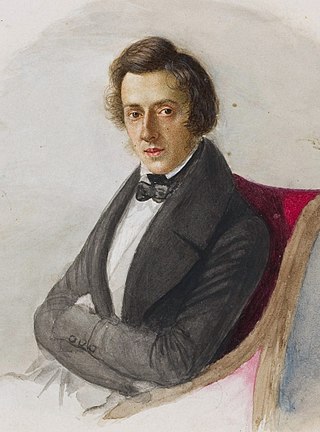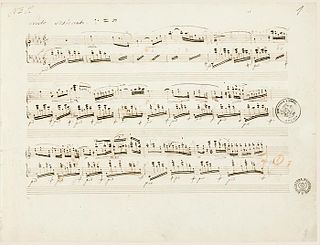
The Prelude in D major, Op. 23 No. 4 is a 1903 composition by Sergei Rachmaninoff. [1] [2] It is part of Rachmaninoff's Ten Preludes, Op. 23.

The Prelude in D major, Op. 23 No. 4 is a 1903 composition by Sergei Rachmaninoff. [1] [2] It is part of Rachmaninoff's Ten Preludes, Op. 23.
The prelude is in ternary form. The theme of the main section is introduced in measure 3:
The theme is in the form of a period, composed of two symmetrical phrases, the consequent being a more embellished version of the antecedent, presenting a triplet descant in the treble voice above the main theme in the right-hand alto voice. The right-hand voices are offset against an eighth-note figure in the left-hand:
The middle section presents rhythmic changes and several modulations. Triplets appear in the accompaniment, and shorter phrasing is utilized:
The piece reaches its climax at measures 50–51, and immediately resolves back into the main section:
Here, the triplet flow returns to the left-hand bass line, while a high counterpoint is introduced in the main melody. Only the antecedent of the original phrase is recapitulated, lengthened by eight additional measures that provide closure.

Ludwig van Beethoven's Piano Sonata No. 3 in C major, Op. 2, No. 3, was written in 1795 and dedicated to Joseph Haydn. It was published simultaneously with his first and second sonatas in 1796.

Six moments musicaux, Op. 16, is a set of solo piano pieces composed by the Russian composer Sergei Rachmaninoff between October and December 1896. Each Moment musical reproduces a musical form characteristic of a previous musical era. The forms that appear in Rachmaninoff's incarnation are the nocturne, song without words, barcarolle, virtuoso étude, and theme and variations.

The Piano Sonata No. 2 in B♭ minor, Op. 35, is a piano sonata in four movements by Polish composer Frédéric Chopin. Chopin completed the work while living in George Sand's manor in Nohant, some 250 km (160 mi) south of Paris, a year before it was published in 1840. The first of the composer's three mature sonatas, the work is considered to be one of the greatest piano sonatas of the literature.
Sergei Rachmaninoff's Prelude in C-sharp minor, Op. 3, No. 2, is one of the composer's most famous compositions. Part of a set of five piano pieces titled Morceaux de fantaisie, it is a 62-bar prelude in ternary (ABA) form. It is also known as The Bells of Moscow since the introduction seems to reproduce the Kremlin's most solemn carillon chimes.
Prelude in G minor, Op. 23, No. 5, is a piece of music by Sergei Rachmaninoff, completed in 1901. It was included in his Opus 23 set of ten preludes, despite having been written two years earlier than the other nine. Rachmaninoff himself premiered the piece in Moscow on February 10, 1903, along with Preludes No. 1 and 2 from Op. 23.

Ludwig van Beethoven's Piano Sonata No. 1 in F minor, Op. 2 No. 1, was written in 1795 and dedicated to Joseph Haydn. It was published simultaneously with his second and third piano sonatas in 1796.

The Nocturnes, Op. 9 are a set of three nocturnes for solo piano written by Frédéric Chopin between 1831 and 1832, published in 1832, and dedicated to Madame Marie Pleyel. These were Chopin's first published set of nocturnes. The second nocturne of the work is often regarded as Chopin's most famous piece.
The Harmonious Blacksmith is the popular name of the final movement, Air and variations, of George Frideric Handel's Suite No. 5 in E major, HWV 430, for harpsichord. This instrumental air was one of the first works for harpsichord published by Handel and is made up of four movements. An air is followed by five doubles : semiquavers in the right hand; semiquavers in the left hand; semiquaver triplets in the right and left hands; and finally demisemiquavers in both hands.

The Nocturnes, Op. 27 are a set of two nocturnes for solo piano composed by Frédéric Chopin. The pieces were composed in 1836 and published in 1837. Both nocturnes in this opus are dedicated to Countess d'Appony.
Excursions, Op. 20, is the first published solo piano piece by Samuel Barber. Barber himself explains:
These are ‘Excursions’ in small classical forms into regional American idioms. Their rhythmic characteristics, as well as their source in folk material and their scoring, reminiscent of local instruments are easily recognized.

The Nocturnes, Op. 55 are a set of two nocturnes for solo piano written by Frédéric Chopin. They are his fifteenth and sixteenth installations in the genre, and were composed between 1842 and 1844, and published in August 1844. Chopin dedicated them to his pupil and admirer Mademoiselle Jane Stirling.

The Prelude in B-Flat Major, Op. 23 No. 2 is a composition by Sergei Rachmaninoff completed and premiered in 1903.

The Prelude in F-sharp minor, Op. 23, No. 1 is a composition by Sergei Rachmaninoff completed and premiered in 1903. It is one of ten preludes composed by Rachmaninoff in 1901 and 1903.

The Prelude in D Minor, Op. 23 No. 3 is a composition by Sergei Rachmaninoff completed and premiered in 1903.

The Prelude in E-flat Major, Op. 23, No. 6 is a 1903 composition by Sergei Rachmaninoff. It is part of Rachmaninoff's Ten Preludes, Op. 23.

The Prelude in C minor, Op. 23, No. 7 is a 1903 composition by Sergei Rachmaninoff. It is part of Rachmaninoff's Ten Preludes, Op. 23.

The Prelude in A-flat major, Op. 23, No. 8, is a 1903 composition by Sergei Rachmaninoff. It is part of Rachmaninoff's Ten Preludes, Op. 23.
The Prelude in E-Flat Minor, Op. 23 No. 9 is a 1903 composition by Sergei Rachmaninoff. It is part of Rachmaninoff's Ten Preludes, Op. 23, and is one of the most difficult of the set.

The Prelude in G-Flat Major, Op. 23 No. 10 is a 1903 composition by Sergei Rachmaninoff. It is part of Rachmaninoff's Ten Preludes, Op. 23.
Alexander Scriabin's 24 Preludes, Op. 11 is a set of preludes composed in the course of eight years between 1888–96, being also one of Scriabin's first published works with M.P. Belaieff in 1897, in Leipzig, Germany, together with his 12 Études, Op. 8 (1894–95).